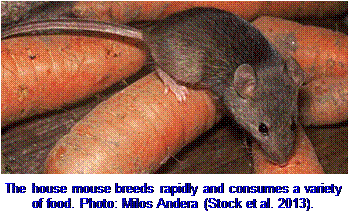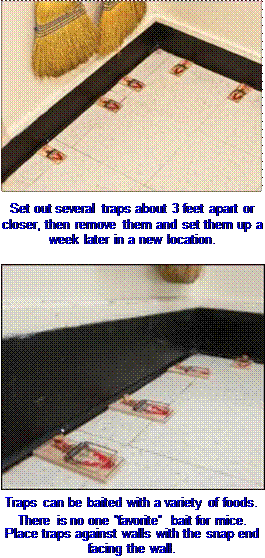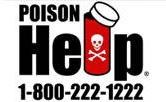
School & Home Integrated Pest Management (IPM) Newsletter – November 2015 View this newsletter as a PDF.
There are many species of rodents, including ground squirrels, rock squirrels, chipmunks, muskrats, beavers, prairie dogs, gophers, packrats, roof rats and a variety of different mice. But do you know that rats and mice are considered the most successful mammals on Earth? In natural environments native rodents play an important role in the health of the environment, and are a major source of food for many predators and scavengers, including hawks, fox, bobcats, coyotes, snakes and even wolves.
 However, some rodents become pests when they infest buildings, threaten public health, and destroy property. The house mouse is one of the most troublesome and economically important rodents in the United States. They feed on and damage food, as well as contaminate food with droppings and urine. They cause structural damage to buildings by building nests and gnawing; they chew on furniture and electrical wires. In addition, house mice can spread disease transmitting pathogens or parasites to humans and pets, including the bacterium Salmonella causing salmonellosis (food poisoning), ringworm, mites, tapeworm and ticks. They generate allergens, which are asthma triggers and should not be tolerated inside homes and schools.
However, some rodents become pests when they infest buildings, threaten public health, and destroy property. The house mouse is one of the most troublesome and economically important rodents in the United States. They feed on and damage food, as well as contaminate food with droppings and urine. They cause structural damage to buildings by building nests and gnawing; they chew on furniture and electrical wires. In addition, house mice can spread disease transmitting pathogens or parasites to humans and pets, including the bacterium Salmonella causing salmonellosis (food poisoning), ringworm, mites, tapeworm and ticks. They generate allergens, which are asthma triggers and should not be tolerated inside homes and schools.
To reduce the threat of rodent-borne diseases, allergens, and other health threats, prevent mice from becoming established inside buildings by finding and sealing up potential access points.
Reduce cluttered storage areas and classrooms. It is best to use transparent plastic totes for storage. If cardboard boxes have not been opened in 2 years, the box and contents may be contaminated with mouse urine and feces and should be recycled or discarded.
Use traps, not poison baits, inside schools or homes. If young children or pets are around consider placing traps inside locked box stations to avoid accidents. Snap trapping results in the fast elimination of mice, but trapping is useless in a cluttered environment. You have to de- clutter if you want to de-mouse. Mice typically do not venture more than 30 feet from their nest (unless food is sparse).
Traps are very effective control devices for mice. They take advantage of their curiosity. Mice will be trapped easily the first night, but they can become trap-shy. On the first night, set six traps in areas of mouse activity (droppings found), positioning each trap 3 feet apart or closer.
 Remove the traps in the morning before students arrive at school or kids emerge from bedrooms at home. Set the traps again a week later in slightly different locations. This technique will help overcome trap-shyness. Handle dead mice and their fecal pellets with caution (see guidance in later sections).
Remove the traps in the morning before students arrive at school or kids emerge from bedrooms at home. Set the traps again a week later in slightly different locations. This technique will help overcome trap-shyness. Handle dead mice and their fecal pellets with caution (see guidance in later sections).
Plastic snap traps (e.g., the Kness Snap-E, J.T. Eaton JAWZ, Bell Trapper Mini Rex, Woodstream Quick Kill, etc.) are more durable and can be cleaned with disinfectants more easily than the disposable traps. The disposable wooden-based traps are an option when all the traps will be collected and disposed of completely.
Traps can be baited with small smudges of chocolate syrup or a few drops of vanilla, orange, or any other extract oils. Despite common myths, there is no one “favorite” bait for mice. Mice are opportunists and will sample most foods they bump into. They forage for nesting materials as well as food, so cotton balls, dental floss, and string may also be used as bait. We don’t recommend peanut butter or anything with nuts in due to possibility of children with tree nut allergies being present. Mice mainly travel along walls to floor junctures, so place traps up against walls with the snap end facing the wall.
Detex Blox contains no poison and is often used by professionals to monitor for mouse activity. Detex Blox is safe and made from 16 human food-grade ingredients, making it ideal for monitoring rat and mouse activity without concern of harming children, pets, or other non-target animals.
The use of poison baits (rodenticides) in schools is a complicated issue, and is best left in the hands of the professionals. As humans are mammals there may be more significant risks and/or liability involved.
Rodenticides around children – only with the greatest of care, when absolutely necessary, and when all else fails!
 Baits are designed to be attractive food resources and may include fish oil, molasses or peanut butter that may be highly attractive to children, non-targets and pets. They may be non-toxic (used to monitor rodent activity) or they may contain a toxin that proves deadly to the rodent when a sufficient amount is consumed. There have been significant changes in rodenticide regulations to reduce rodenticide hazards to wildlife, pets and children. Manufacturers are now required to produce over-the-counter products that are sold as ready-to-use, disposable bait stations. Agricultural producers and professional pest management professionals have access to a wider array of rodenticide options, including restricted use pesticides in a variety of forms.
Baits are designed to be attractive food resources and may include fish oil, molasses or peanut butter that may be highly attractive to children, non-targets and pets. They may be non-toxic (used to monitor rodent activity) or they may contain a toxin that proves deadly to the rodent when a sufficient amount is consumed. There have been significant changes in rodenticide regulations to reduce rodenticide hazards to wildlife, pets and children. Manufacturers are now required to produce over-the-counter products that are sold as ready-to-use, disposable bait stations. Agricultural producers and professional pest management professionals have access to a wider array of rodenticide options, including restricted use pesticides in a variety of forms.
Anticoagulants cause blood-thinning in almost all warm-blooded animals. These products stop the normal blood clotting process. They are a relatively humane toxicant that causes little in the way of pain and suffering. The rodenticides are slow acting and animals may continue to be active for up to a week before dying. The animal dies of internal bleeding. Until recently there were two types of anticoagulants available: the first-generation type required multiple doses to cause the death of the animal and a second-generation type that may be fatal after only one feeding. Additionally, second generation anticoagulants are not easily excreted from the body, and they can be stored in the liver. Due to the higher relative risk, the second-generation anticoagulants are no longer allowed for sale to the general public. Consumers are now able to purchase only prepackaged, ready-to-use bait stations containing the first-generation anticoagulants (e.g. warfarin, chlorophacinone, or diphacinone) or non-anticoagulants (e.g. bromethalin or cholecalciferol).
There are several non-anticoagulant toxicants used in rodenticides. In general they pose higher relative risks to non-target organisms and are less suitable for use around children (some are prohibited on school grounds).
There are restrictions on zinc phosphide, aluminum phosphide and magnesium phosphide based products. Depending where you live they may NOT be permitted for use on school grounds (there may be an allowance for athletic fields under some circumstances). Following ingestion, zinc phosphide reacts with the gastric acid in the stomach. The result is phosphine gas that causes damage to the small blood vessels, red blood cells, and blood vessels in the kidneys, liver, and lungs. Sadly, multiple child fatalities have occurred due to accidents and misuse.
Rodenticides have historically ranked second in the number of human exposures to pesticides each year compared with the three other major categories of pesticides (American Association of Poison Control Centers).
Product names mentioned are registered trademarks. Any products, services, or organizations that are mentioned, shown, or indirectly implied in this publication do not imply endorsement by The University of Arizona.
There are many steps and strategies you can take before resorting to rodenticide baits, especially around children. See the following resources for more information.
Read more information about IPM of the house mouse in schools (Stock et al. 2013): http://ir.library.oregonstate.edu/xmlui/bitstream/handle/1957/38106/em9062.pdf
See the videos in this three-part series “IPM for Mice – Exclusion, Sanitation, Trapping”:
http://www.sustainableplaces.org/general-ipm/mouse-control-exclusion http://www.sustainableplaces.org/general-ipm/ipm-for-mice-sanitation http://www.sustainableplaces.org/general-ipm/ipm-for-mice-trapping
House mouse: http://cals.arizona.edu/urbanipm/pest_press/2004/dec.pdf
Mice: http://cals.arizona.edu/urbanipm/pest_press/2004/feb.pdf
Rodenticides: http://npic.orst.edu/factsheets/rodenticides.html